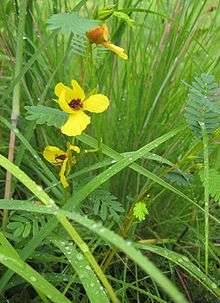Chamaecrista fasciculata
Chamaecrista fasciculata, the partridge pea, is a species of legume native to most of the eastern United States.[1] It is an annual which grows to approximately 0.5 meters tall.[1] It has bright yellow flowers from early summer until first frost,[2] with flowers through the entire flowering season if rainfall is sufficient.[1]
| Chamaecrista fasciculata | |
|---|---|
 | |
| Scientific classification | |
| Kingdom: | |
| (unranked): | |
| (unranked): | |
| (unranked): | |
| Order: | |
| Family: | |
| Genus: | |
| Species: | C. fasciculata |
| Binomial name | |
| Chamaecrista fasciculata (Michx.) Greene | |
| Synonyms | |
| |
The flowers are hermaphroditic, although a fraction of plants, less than 5%, do not produce sufficient pollen to reproduce as males. This phenomenon has been studied in a variety of plants as a possible evolutionary step towards dioecy, in which male and female flowers occur on separate plants.[2] C. fasciculata is pollinated only by bees.[3]
The flowers have yellow anthers that produce reproductive pollen, and purple anthers that produce food pollen, but no nectar.[1] Long-tongued bees such as bumblebees, honey bees, long-horned bees, and leafcutting bees pollinate the flowers. There are extrafloral nectaries on the leaf stems, which attract a different set of insects: sweat bees, flies, wasps, and ants.[4]
It thrives in areas that have been burned recently before declining in number in the following years.[1] It is considered an excellent choice for planting in disturbed areas, as it will quickly cover an area, preventing erosion, while still allowing other plants to become established.[1] It is also grown as an ornamental or for honey production.[1]
Description
The leaves consist of 10 to 15 pairs of small, narrow leaflets that are somewhat delicate to the touch. The showy yellow flowers, about 1 inch across, grow 2 to 4 together in clusters on the stem. Flowers normally bloom July-September. The fruit is a straight, narrow pod 1½ to 2½ inches long, which splits along 2 sutures as it dries; the pod sides spiral to expel the seeds some distance from the parent plant.[5]
Wildlife
The seed is one of the major food items of northern bobwhite and other quail species because it remains in sound condition throughout the winter and early spring. Partridge pea was found to be one of the most important fall and winter foods of bobwhite quail in Alabama. Partridge pea seeds are high in phosphorus content and protein value, and low in crude fiber and lignin making digestibility generally high. Seeds of this legume are also eaten by the greater and lesser prairie-chicken, ring-necked pheasant, mallard, grassland birds, and field mice. Partridge pea often grows in dense stands, producing litter and plant stalks that furnish cover for upland game birds, small mammals, small non-game birds, and waterfowl. Partridge pea is considered an important honey plant, often occurring where few other honey plants are found. Nectar is not available in the flowers of showy partridge pea but is produced by small orange glands at the base of each leaf. Ants often seek the nectar and are frequent visitors. The common sulfur butterfly lays its eggs on the leaves, and the larvae use the leaves as a food source.[5]
References
- Tesky, Julie L. (1992). "Chamaecrista fasciculata". Fire Effects Information System (FEIS). US Department of Agriculture (USDA), Forest Service (USFS), Rocky Mountain Research Station, Fire Sciences Laboratory. Retrieved 2019-03-12 – via https://www.feis-crs.org/feis/.
- Holly L. Williams and Charles B. Fenster (1998). "Ecological and genetic factors contributing to the low frequency of male sterility in Chamaecrista Fasciculata (Fabaceae)". American Journal of Botany. Botanical Society of America. 85 (9): 1243–1250. doi:10.2307/2446634. JSTOR 2446634.
- TD Lee, FA Bazzaz (1982). "Regulation of fruit and seed production in an annual legume, Cassia fasciculata". Ecology. Ecology, 1982. 63 (5): 1363–1373. doi:10.2307/1938864. JSTOR 1938864.
- Hilty, John (2016). "Partridge Pea". Illinois Wildflowers.
- "PARTRIDGE PEA" (PDF). Plants.udsa.gov.

External links
- Charles B. Fenster (1991). "Gene flow in Chamaecrista fasciculata (Leguminosae) I. Gene dispersal" (PDF). Evolution. 45 (2): 398–409. doi:10.1111/j.1558-5646.1991.tb04413.x. PMID 28567876.